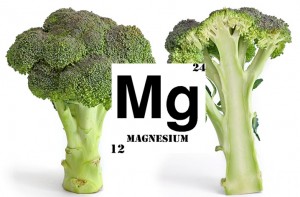Why magnesium is important
Magnesium is the fourth most abundant element in the Earth and it also plays an important physiological role in many life-supporting processes. Elemental magnesium is classified as alkaline earth metal which is chemically reactive enough to not to occur in nature: It reacts slowly with oxygen and water at ambient temperature. On heating in the air at elevated temperatures magnesium can be ignited to produce extremely bright white light and magnesium oxide, a common antacid, magnesium supplement, and a short-term laxative.
Magnesium: The biological role
Biologically available magnesium is presented by a variety of compounds where the metal is oxidized to its common Mg2+ cationic state. Magnesium is the eleventh-most-abundant element by weight in the human body. It plays a fundamental catalytic role as a co-factor in a variety of enzymatic reactions involving energy metabolism (glycolysis – glucose catabolism). Over 300 enzymes require the presence of magnesium ions for their catalytic action, including all enzymes utilizing or synthesizing ATP, or those that use other nucleotides to synthesize DNA and RNA. ATP exists in cells normally as a chelate of ATP and magnesium (Mg2+) ion. In vegetation, magnesium is the metallic ion at the center of chlorophyll.
An adult human body contains approximately 25 g of magnesium, with up to 60% present in the bones and the rest in soft tissues. Normal serum magnesium concentrations are in the range of 18 – 25 mg/L which form less than 1% of the total magnesium in the body. Hypomagnesemia is low magnesium condition when serum magnesium level drops below 18 mg/L. Magnesium homeostasis is controlled by the kidney, which typically excretes about 120 mg magnesium into the urine daily. Reference Daily Intake of magnesium for an adult person is around 400 mg.
Dietary studies of people in the United States consistently show that intakes of magnesium are lower than recommended amounts. People get magnesium from their diet, but sometimes magnesium supplements are needed if magnesium levels are too low. Dietary intake of magnesium may be particularly low among women.
 Health effects of low magnesium
Health effects of low magnesium
According to the Office of Dietary Supplements, “Habitually low intakes or excessive losses of magnesium due to certain health conditions like chronic alcoholism, and/or the use of certain medications can lead to magnesium deficiency. Early signs of magnesium deficiency include loss of appetite, nausea, vomiting, fatigue, and weakness. As magnesium deficiency worsens, numbness, tingling, muscle contractions and cramps, seizures, personality changes, abnormal heart rhythms, and coronary spasms can occur.”
The chronic diarrhea and fat malabsorption resulting from Crohn’s disease, gluten-sensitive enteropathy (celiac disease), and regional enteritis can lead to magnesium depletion over time. Chronic magnesium deficiency can occur in people with insulin resistance and/or type 2 diabetes because magnesium is involved in insulin secretion, binding, and activity. Older adults have lower dietary intakes of magnesium and also magnesium absorption from the gut decreases and renal magnesium excretion increases with age.
Health benefits of dietary magnesium
Diets with higher amounts of magnesium are associated with a significantly lower risk of diabetes because of the important role of magnesium in glucose metabolism. Magnesium intake was inversely associated with incidence of type 2 diabetes – it was found that a 100 mg/day increase in total magnesium intake decreased the risk of diabetes by a statistically significant 15%. This finding suggests that increased consumption of magnesium-rich foods such as whole grains, beans, nuts, and green leafy vegetables may reduce the risk of type 2 diabetes. The body of evidence from epidemiological studies consistently shows a strong inverse relationship between dietary magnesium intake and the risk of developing type 2 diabetes. Also low serum magnesium levels have been associated with a higher risk of developing metabolic syndrome.
Magnesium is involved in bone formation and influences the activities of osteoblasts and osteoclasts. Diets that provide recommended levels of magnesium enhance bone health, but further research is needed to elucidate the role of magnesium in the prevention and management of osteoporosis.
Magnesium deficiency may play an important role in the developing of migraine headaches. Studies have shown that preventive treatment with oral magnesium and acute headache treatment with intravenous magnesium may be effective. People who experience migraine headaches have lower levels of serum and tissue magnesium than those who do not. Magnesium therapy is recommended for patients with ventricular arrhythmia.
Magnesium is also used for treating attention deficit-hyperactivity disorder (ADHD), anxiety, chronic fatigue syndrome (CFS), Lyme disease, fibromyalgia, leg cramps during pregnancy, diabetes, kidney stones, migraineheadaches, weak bones (osteoporosis), premenstrual syndrome (PMS), altitude sickness, urinary incontinence, restless leg syndrome, asthma, hayfever, multiple sclerosis, and for preventing hearing loss.
Athletes sometimes use magnesium to increase energy and endurance. Yes, I believe that in combination with my overall healthy diet, some extra magnesium I take as a supplement may contribute into my strength building and faster muscle recovery so that I can do heavy squats (over 315 pounds for multiply reps) four days in a row. Needless to say, that in my 57 I am not familiar with feeling low energy or low testosterone.
But remember: Anything can be toxic when taken in excess, no exceptions. Therefore, do not turn your friend against you by being unreasonable consumer. Too much magnesium from food does not pose a health risk in healthy individuals because the kidneys eliminate excess amounts with the urine. However, high doses of magnesium may come with dietary supplements or medications e. g., milk of magnesia as antacid or Epsom salt as a laxative often result in diarrhea that can be accompanied by nausea and abdominal cramping.
Magnesium: dietary sources
Dietary sources of magnesium include legumes, whole grains, vegetables (especially broccoli, squash, and green leafy vegetables), seeds, and nuts (especially almonds). Other sources include dairy products, meats, chocolate, and coffee. Hard water also contains magnesium along with calcium and other metal ions. According to the American Society of Nutritional Sciences, the top 10 contributors to dietary magnesium intake were ground coffee (3.7% of intake), 2% milk (2.6%), whole milk (2.1%), raw bananas (1.8%), beer (1.8%), skim or nonfat milk (1.5%), orange juice (1.5%), lite beer (1.4%), French fries (1.1%) and 1% milk (0.9%).
In general, I cannot agree more with what Dietary Guidelines for Americans 2010 recommends in the chapter titled Principles for Achieving a Healthy Eating Pattern (except fat-free and low-fat milk; I prefer and recommend WHOLE MILK because it is obviously less processed and more nutritious):“Dietary supplements or fortification of certain foods may be advantageous in specific situations to increase intake of a specific vitamin or mineral. …A healthy eating pattern focuses on nutrient-dense foods – vegetables, fruits, whole grains, fat-free or low-fat milk and milk products, lean meats and poultry, seafood, eggs, beans and peas, and nuts and seeds that are prepared without added solid fats, sugars, starches, and sodium. Combined into an eating pattern, these foods can provide the full range of essential nutrients and fiber, without excessive calories.” Please also read this: Stop wasting money on supplements. As always, balance is important: it is critical to balance your caloric intake with energy expenditure!
Category: Healthy diet, Supplements










Several experimental studies suggest a protective role of magnesium intake against diabetes. Using a rat model of spontaneous type 2 diabetes, Balon et al. ( 32 ) demonstrated a significant reduction in the incidence of diabetes after 7 weeks of feeding with a magnesium-rich diet. In humans, some ( 11 , 33 , 34 ) but not all ( 35 – 37 ) experimental studies have shown benefits of magnesium supplements on glucose metabolism and/or insulin sensitivity. Some of the inconsistencies among these studies can be explained by differences in treatment periods, doses of magnesium, and parameters used to evaluate the effect. Moreover, most of these studies have been conducted on diabetic subjects, in whom the underlying insulin resistance could interfere with magnesium uptake at the cellular level ( 38 ). In one study ( 11 ), elderly nondiabetic subjects participated in a double-blind, randomized, crossover study comparing magnesium supplements (4.5 g/day) versus placebo during 4 weeks. This study showed a beneficial effect on insulin response to glucose and insulin action. Whether long-term magnesium supplementation decreases the risk for type 2 diabetes in the general population is unclear, and the hypothesis merits testing in clinical trials. In our observational analysis, magnesium supplement use was not significantly associated with diabetes risk in multivariate models. However, the power of our study was limited by the low prevalence of magnesium supplement use in these cohorts.
however, people that ingest large amounts of milk of magnesia (as a laxative or antacid), epsom salts (as a laxative or tonic), or magnesium supplements may overdose, especially if they suffer from kidney problems. Too much magnesium can cause several serious health problems, including nausea, vomiting, severely lowered blood pressure, confusion, slowed heart rate, respiratory paralysis, deficiencies of other minerals, coma, cardiac arrhythmia, cardiac arrest, and eventually death.
You are right – and no surprise. It is good to always keep in mind: Anything is toxic when overly consumed. No exceptions. You can kill yourself by drinking a gallon of pure water too fast. See http://en.wikipedia.org/wiki/Water_intoxication